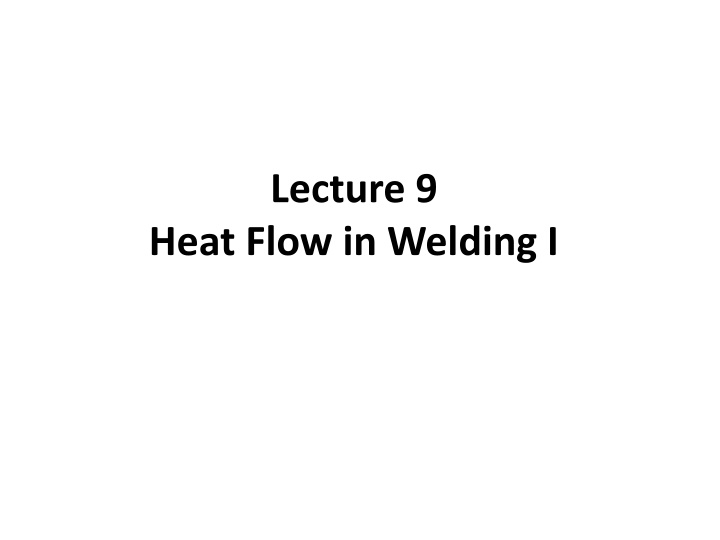
Heat Flow and Welding Zones in Welding Processes
Explore the heat flow in welding, welding zones, welding thermal cycle, and the impact of cooling rate on grain structure during solidification. Understand the factors affecting welding thermal cycle, such as heat input rate, welding geometry, and base metal properties. Discover the importance of optimal power density in welding processes and its effect on material properties.
Download Presentation

Please find below an Image/Link to download the presentation.
The content on the website is provided AS IS for your information and personal use only. It may not be sold, licensed, or shared on other websites without obtaining consent from the author. If you encounter any issues during the download, it is possible that the publisher has removed the file from their server.
You are allowed to download the files provided on this website for personal or commercial use, subject to the condition that they are used lawfully. All files are the property of their respective owners.
The content on the website is provided AS IS for your information and personal use only. It may not be sold, licensed, or shared on other websites without obtaining consent from the author.
E N D
Presentation Transcript
Lecture 9 Heat Flow in Welding I
Weld Thermal Cycle -Weld thermal cycle shows variation in temperature of location during the welding as a function of welding time. As the heat source approaches close to welding location :temperature, heating regime and cooling regime increase
Effect Of Cooling Rate On Grain Structure During Solidification
Heat Flow in Welding- Importance -Melting and solidification steps of welding are associated with the flow of heat are affected by rate of heat transfer in and around the weld metal -Metallurgical structure of metal in weld and region close to the weld metal is mainly determined by the extent of rise in temperature and then cooling rate of the metal at location of HAZ and weld -Peak temperature near the weld fusion boundary decides the width of heat affected zone (HAZ). -Heating and cooling rate affect the microstructure of weld metal and HAZ therefore weld thermal cycle of each point becomes of great interest especially in structure sensitive metals like high carbon steels.
Factors affecting welding thermal cycle -Beside distance, weld thermal cycle also influenced by heat input rate, amount of heat supplied for welding, weldment geometry, thermal properties of base metal and initial plate temperature. -Rate of heat input is primarily governed by the energy density of heat input source. Increases in heat input decreases the cooling rate while reverse happens. -High energy density processes like plasma arc welding and laser beam welding offer higher rate of heating, peak temperature and cooling rates than low energy density processes such as gas welding, shielded metal arc welding -Higher is the energy density of welding process, lower will be the heat input. - Increase thickness increasing cooling rate. -Increase of initial plate temperature during welding lowering CR
Need of optimum power density of welding process High heat input lowers the tensile strength of many aluminum alloy due to: thermal softening of HAZ and development of undesirable metallurgical properties of the weldment Use of high power density offers many advantages such as: deep penetration, high welding speed and improved quality of welding joints effect of heat input on tensile strength of aluminum alloy weld joints
Factors affecting welding thermal cycle -Thicknessof plates being welded also affect the heating rate and cooling rate an increase in thickness increases the rate of heat transfer from the weld pool/heat affected zone to the base metal which in turn: a)decreases the high temperature keeping time of HAZ, b) decreases the solidification time and c) increases the cooling rate experienced by the HAZ and weld metal. -Thermal properties of metal like thermal conductivity and specific heat also have affect on weld thermal cycle similar to that of thickness of plates as they increase the rate of heat transfer from the weld metal and HAZ. -Preheating of the plates reduces the rate of heating and cooling and increases the peak temperature because preheating reduces the rate of heat transfer away from the weld zone.
Cooling Rate Figure below shows that the Colling rate decided the the final phase formed (letter A, F, P, B, M indicates regions of austenite, ferrite, pearlite, bainite and martensit respectively) of hypo-eutectoid steel Increase Colling rate Decrease Formation M phase Formation P phase
Cooling Rate -Cooling rate above a particular temperature say 550 oC for plain carbon, eutectoid steel is of great importance in case of harden able steel -where a cooling rate (CR) determines the final microstructure and mechanical properties of weldment and HAZ. -In view of above, major practical application of cooling rate equation is to determine the preheat requirement for plate to be welded so as to avoid critical cooling rate in weld and HAZ. -Net heat input (Hnet) during welding is obtained using following relationship: Hnet = f . V. I / S where V is arc voltage (V), I welding current (A) and welding speed mm/sec and f is the fraction of heat generated and transferred to the plate. S
